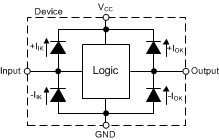ZHCSKE5 October 2019 SN74HCS72-Q1
PRODUCTION DATA.
8.3.3 Positive and Negative Clamping Diodes
The inputs and outputs to this device have both positive and negative clamping diodes as depicted in Figure 11.
CAUTION
Voltages beyond the values specified in the Absolute Maximum Ratings table can cause damage to the device. The input negative-voltage and output voltage ratings may be exceeded if the input and output clamp-current ratings are observed.
 Figure 11. Electrical Placement of Clamping Diodes for Each Input and Output
Figure 11. Electrical Placement of Clamping Diodes for Each Input and Output